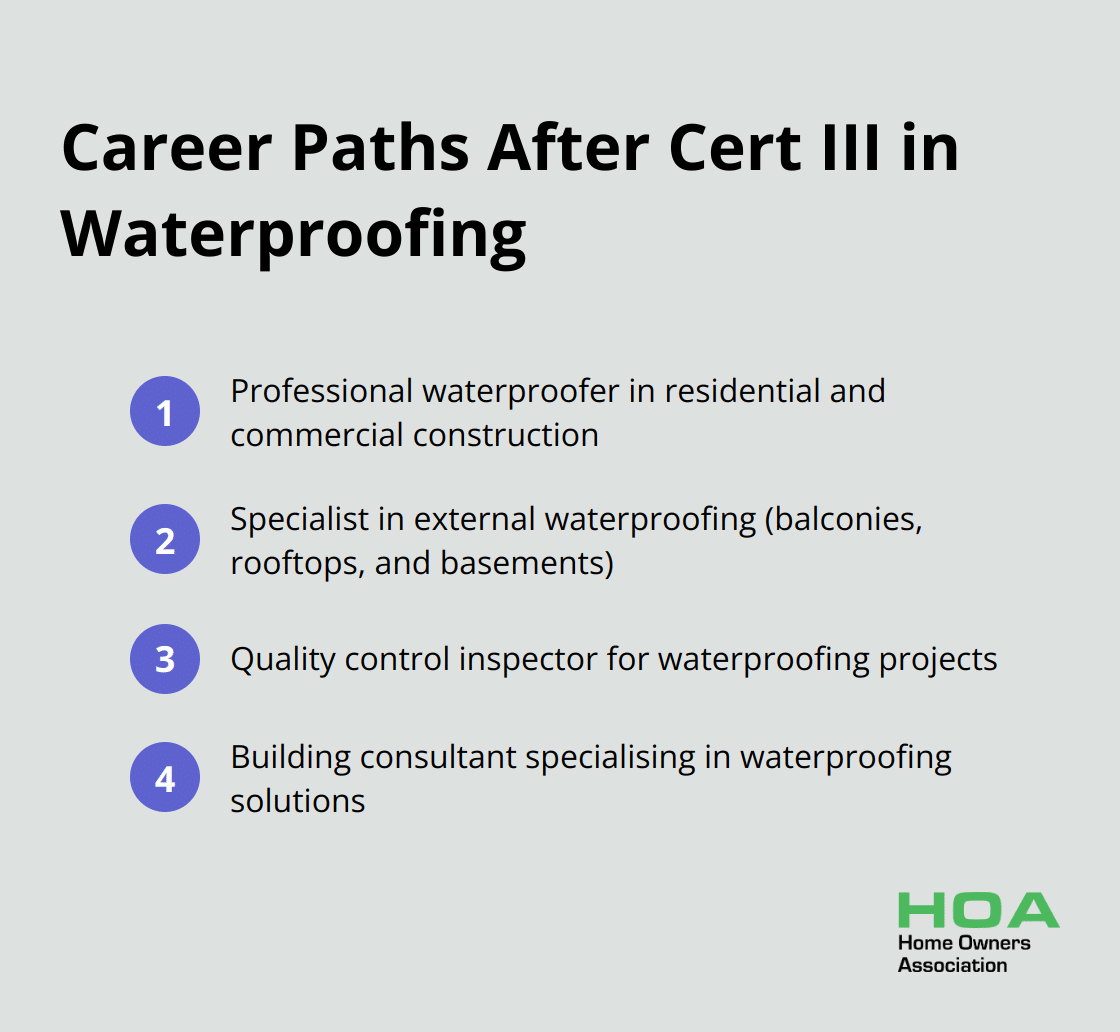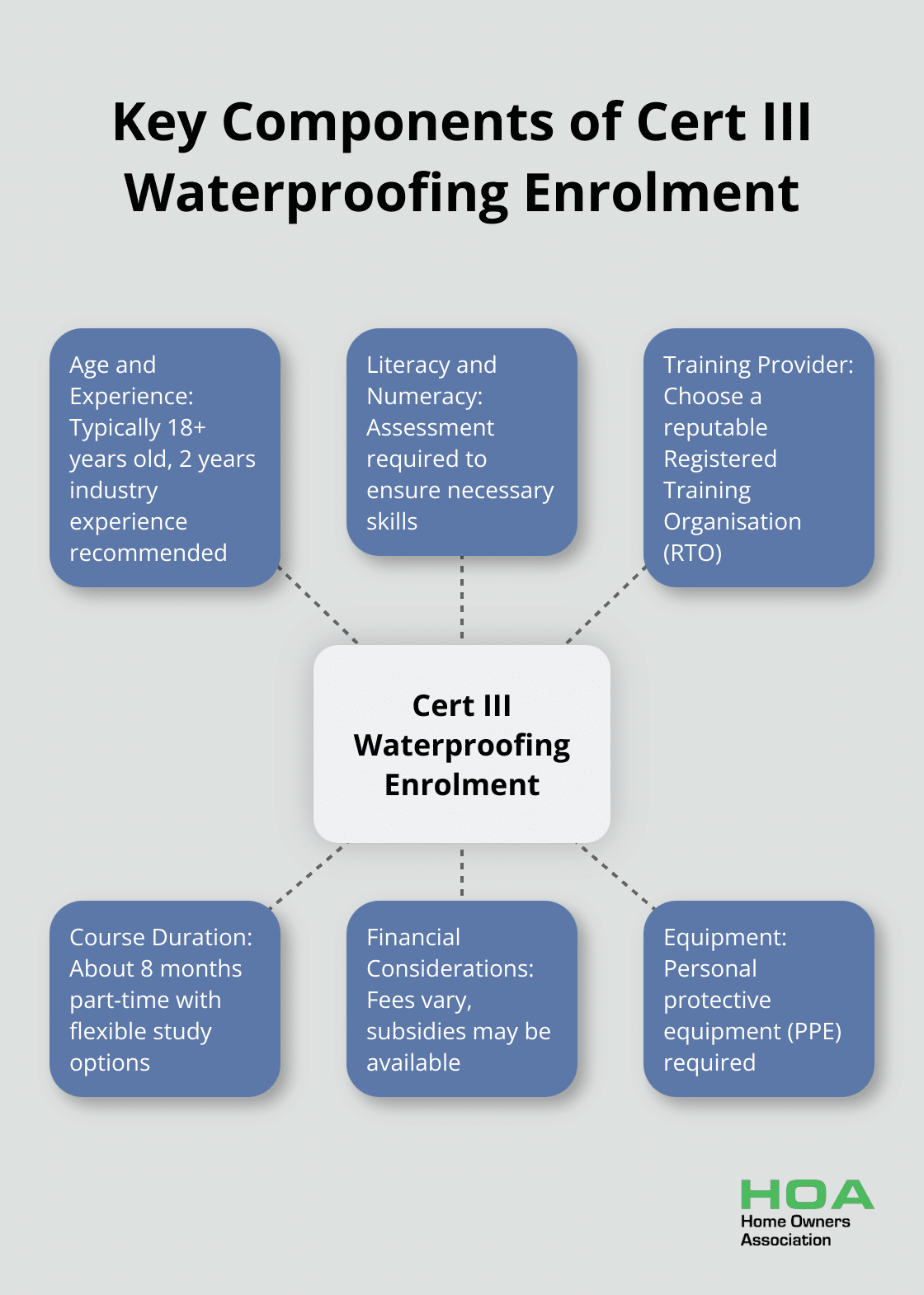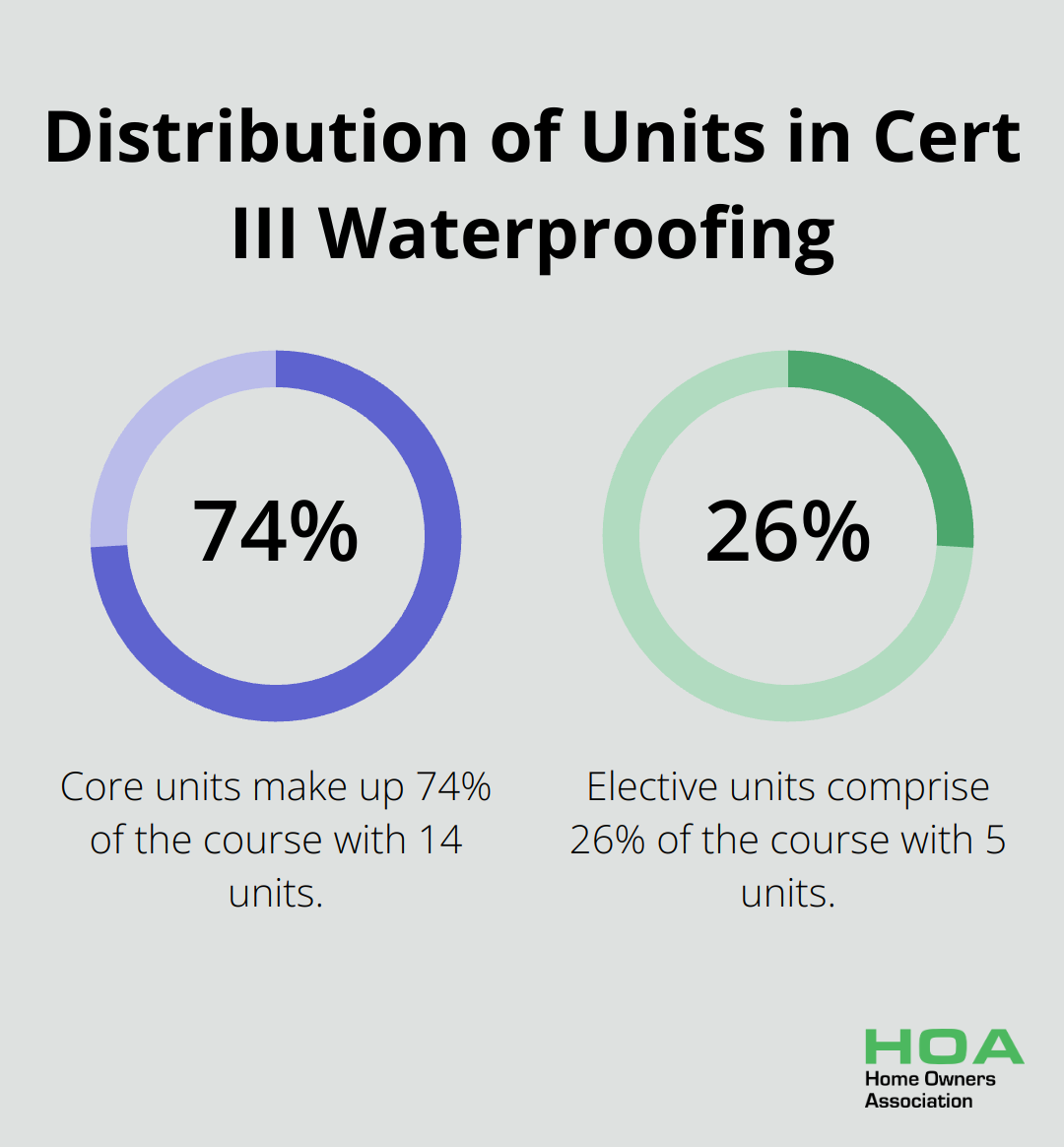
At Home Owners Association, we understand the importance of proper waterproofing for maintaining the integrity of your property.
Obtaining a Cert III in Waterproofing can be a game-changer for those looking to excel in this crucial field.
This comprehensive guide will walk you through the process of acquiring this valuable certification, from understanding the qualification to completing the necessary coursework.
What Is Cert III in Waterproofing?
Qualification Overview
The Certificate III in Construction Waterproofing (CPC31420) stands as a nationally recognised qualification in Australia. This certification provides the practical skills required to undertake a range of waterproofing tasks in the commercial or residential construction industry.
Course Structure and Duration
The Cert III in Waterproofing comprises 19 units of competency (14 core units and 5 specialty units focused on waterproofing tasks). Training organisations typically offer this course part-time over approximately 8 months. The flexible schedule includes evening sessions and Saturday classes, which accommodates working professionals seeking to enhance their skills.
Career Prospects
Graduates of the Cert III in Waterproofing can expect promising career opportunities. The Australian Government’s Job Outlook service projects significant job growth in the construction industry over the next five years. This forecast indicates a strong demand for skilled professionals in the field.
Successful completion of the course can lead to various career paths:

Essential Skills and Knowledge
The Cert III in Waterproofing provides a comprehensive set of skills and knowledge essential for success in the industry. Students learn practical techniques for surface preparation and waterproofing application in various settings, ensuring job readiness upon graduation.
Key areas of study include:
- Handling and storing waterproofing materials
- Using specialised waterproofing tools and equipment
- Applying waterproofing processes to internal and external areas
- Assessing and implementing appropriate waterproofing systems
- Adhering to workplace health and safety requirements
Industry Recognition and Benefits
The certification’s national recognition enhances employment opportunities across Australia. Proper waterproofing contributes significantly to the integrity and longevity of properties. This qualification not only opens doors to rewarding career opportunities but also plays a vital role in maintaining the overall quality and safety of construction projects throughout the country.
As we move forward, let’s explore the steps required to obtain your Cert III in Waterproofing, including prerequisites, choosing a training organisation, and understanding course options.
How to Enrol in a Cert III Waterproofing Course

Age and Experience Requirements
Most training organisations require students to be at least 18 years old to enrol in the Cert III Waterproofing course. While not always mandatory, two years of industry experience is highly recommended. This prior exposure to construction or related fields can significantly enhance your learning experience and job prospects post-certification.
Literacy and Numeracy Assessment
Before enrolment, you’ll need to complete a literacy and numeracy assessment. This evaluation ensures you have the necessary skills to succeed in the course. Many training providers offer support services to help you improve these skills if needed.
Choosing the Right Training Provider
Selecting a reputable Registered Training Organisation (RTO) is important. Look for providers with strong industry connections and up-to-date facilities. TAFE institutions across Australia offer this certification, but private RTOs are also available. Check the training.gov.au website for a list of approved providers in your area.
Course Duration and Flexibility
The Cert III in Waterproofing typically takes about 8 months to complete when studied part-time. Many providers offer flexible study options, including evening classes and weekend sessions. This flexibility benefits those who are currently working or have other commitments.
Financial Considerations
Course fees vary depending on the provider and your eligibility for government subsidies. In some states (like Queensland), apprentices under 25 may qualify for fully subsidised training. Always inquire about potential funding options or payment plans when discussing enrolment with your chosen RTO.
Equipment and Materials
Prepare to invest in personal protective equipment (PPE) such as safety boots, safety pants, and work shirts. These items are essential for the practical components of the course. Some training providers might include these in your course fees, so ask about this during your enrolment process.
The next step in your journey to becoming a certified waterproofer involves understanding the key components of the Cert III in Waterproofing course. Let’s explore the core units, practical training, and industry placement requirements that will shape your learning experience.
What’s Inside a Cert III Waterproofing Course?
Core and Elective Units
The Certificate III in Construction Waterproofing program consists of 19 units of competency: 14 core units and 5 elective units. Core units cover essential skills such as workplace health and safety, effective communication, and basic construction principles. Elective units allow you to specialise in areas like internal waterproofing, external waterproofing for balconies and rooftops, or below-ground waterproofing techniques.

Some of the most important units you’ll encounter include:
- Handling and storing waterproofing materials
- Using waterproofing tools and equipment
- Preparing surfaces for waterproofing applications
- Applying waterproofing to internal and external wet areas
These units ensure you become well-versed in all aspects of waterproofing, from preparation to application.
Hands-on Training and Assessment
A significant portion of the Cert III in Waterproofing involves practical, hands-on training. You’ll spend time in industry-standard workshops, learning to use tools like trowels, paint brushes, rollers, and heat welding gear for torch-on membranes. This practical experience closely mimics real-world scenarios you’ll encounter on the job.
Assessments are primarily activity-based, focusing on your ability to demonstrate skills in realistic scenarios. You might receive tasks such as waterproofing a mock-up bathroom or applying a membrane to an external surface. These assessments test your technical skills and your ability to work safely and efficiently.
Industry Exposure
While not all programs require formal industry placement, many incorporate some form of work experience or simulated work environment. This exposure to real-world applications proves vital for solidifying your skills and understanding industry standards.
If your course doesn’t include a formal placement, try to seek out opportunities to shadow experienced waterproofers or volunteer on relevant projects. This practical experience can significantly enhance your employability upon graduation.
Specialised Knowledge
The Cert III in Waterproofing provides in-depth knowledge of various waterproofing systems and their applications. You’ll learn about different types of membranes (liquid applied, sheet, and cementitious), their properties, and appropriate use cases. Understanding building codes and Australian Standards related to waterproofing (such as AS 3740 for waterproofing of domestic wet areas) forms a key part of the curriculum.
Safety and Compliance
A strong emphasis on workplace health and safety permeates throughout the course. You’ll learn about proper handling of materials (some of which may be hazardous), correct use of personal protective equipment (PPE), and safe work practices on construction sites. This focus on safety ensures you’re prepared to work responsibly in various environments.
Final Thoughts
A Certificate III in Waterproofing opens doors to a successful career in construction. This certification equips professionals with specialised skills in surface preparation, waterproofing application, and safety protocols. Graduates gain a deep understanding of various waterproofing systems and their appropriate uses, which translates into increased job opportunities and higher earning potential.
Aspiring waterproofing professionals should seek employment opportunities and continue to build practical experience after certification. Networking with other professionals and joining industry associations can lead to new opportunities and knowledge-sharing. Staying updated on industry advancements will help maintain a competitive edge in the field.
At Home Owners Association, we understand the importance of quality waterproofing for property integrity. Our members can access trade pricing and discounts on construction materials (including those used in waterproofing projects). We also provide expert advice to ensure all home improvement projects meet high standards of quality.





